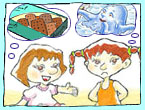Communicative functions: Interacting with others
| Adjusting our interactions with others |
Introduction
When we interact with others, we build relationships with them. As we build relationships, we often try to adjust, soften or temper our point of view so that other people in the interaction are able to express their point of view as well.
The most direct way to express our point of view is to be either positive or negative:

|
The water in the harbour is
polluted, but the water in the swimming pools isn't
polluted.
The children like chocolate biscuits but they don't like MegaMonster. |
 |
Sometimes we don't want to express our point of view so directly and we adjust our
language in the following ways:
|
We take a position somewhere between positive and negative.
|
|
We attribute this point of view
to someone else.
|
For more information about responding to requests, see:
![]() Text types:
Particular Descriptions: Expressing feelings and opinions
Text types:
Particular Descriptions: Expressing feelings and opinions
![]() Text
types: Recounts: Expressing feelings and opinions
Text
types: Recounts: Expressing feelings and opinions
![]() Text
types: Stories: Building atmosphere and suspense
Text
types: Stories: Building atmosphere and suspense
![]() Grammar: Groups & phrases:
Verb group: Adjusting interactions: modality:
Overview
Grammar: Groups & phrases:
Verb group: Adjusting interactions: modality:
Overview
|
||
To give us feedback about this section, click here or on the Comment button at the top of the screen.
If you have any questions about this section, visit the Language Corner.
If you have any questions or suggestions about how to teach this section, send a message to the Teaching Corner.